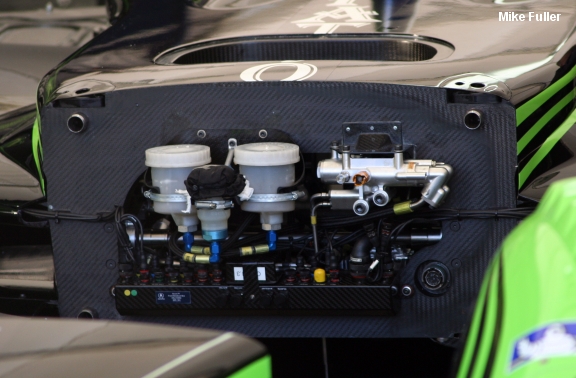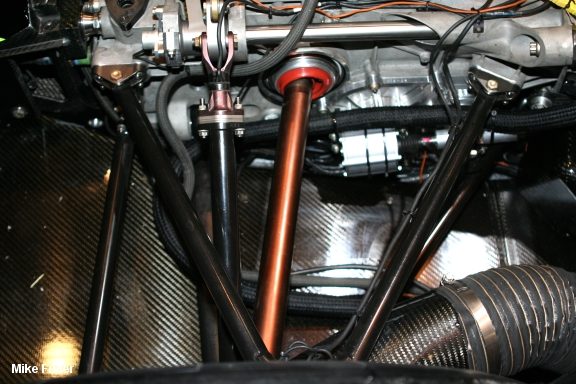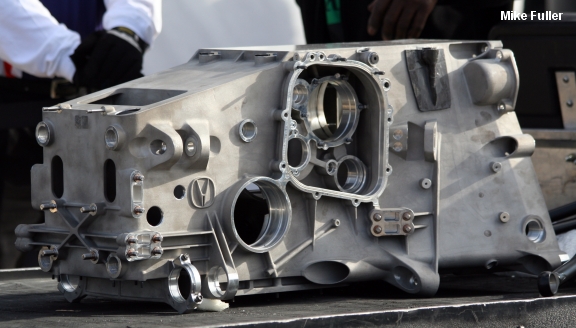 Precious
little of the front suspension is visible being either closed up within
the shrouds or enclosed within the monocoque. The hatch on
top of the monocoque allows access to the dampers, 3rd spring,
anti-roll,
and torsion bars. Here
we can
simply see the reservoir for the clutch and brake master cylinders as
well as the actuator for the hydraulic power steering. The
use of
hydraulic power steering is bucking the recent trend of electric power
steering (EPS) units
and Wirth indicates that the choice of a hydraulic power steering was
for a singular reason, "Packaging rules here, end of story..."
An
EPS needs to be mounted to the front of the monocoque in order to
engage the steering rack and this puts the weight up high, especially so given the
raised tub nature of contemporary monocoques. With a hydraulic unit, the pump itself is
back
with the engine and only the actuator unit is mounted to the
front of
the tub. The actuator unit itself weighs much less than the
EPS and helps
remove weight from up high though the hydraulic pump and actuator all
told weigh about the same as the EPS. So it's a matter of
reducing CG as it is always better to place weight low.
Precious
little of the front suspension is visible being either closed up within
the shrouds or enclosed within the monocoque. The hatch on
top of the monocoque allows access to the dampers, 3rd spring,
anti-roll,
and torsion bars. Here
we can
simply see the reservoir for the clutch and brake master cylinders as
well as the actuator for the hydraulic power steering. The
use of
hydraulic power steering is bucking the recent trend of electric power
steering (EPS) units
and Wirth indicates that the choice of a hydraulic power steering was
for a singular reason, "Packaging rules here, end of story..."
An
EPS needs to be mounted to the front of the monocoque in order to
engage the steering rack and this puts the weight up high, especially so given the
raised tub nature of contemporary monocoques. With a hydraulic unit, the pump itself is
back
with the engine and only the actuator unit is mounted to the
front of
the tub. The actuator unit itself weighs much less than the
EPS and helps
remove weight from up high though the hydraulic pump and actuator all
told weigh about the same as the EPS. So it's a matter of
reducing CG as it is always better to place weight low. There's
an upright in there some where we're told.
There's
an upright in there some where we're told. At
the rear the pushrod engages the torsion bar (1) via the bellcrank
which in turn actuates the dampers (2) and the third spring (3).
The length of the torsion bar is driven by the desire to keep
them from breaking. The front torsion bars are similarly
long. Note the A-arms are tube cross section.
At
the rear the pushrod engages the torsion bar (1) via the bellcrank
which in turn actuates the dampers (2) and the third spring (3).
The length of the torsion bar is driven by the desire to keep
them from breaking. The front torsion bars are similarly
long. Note the A-arms are tube cross section. The
third damper is a through-shaft type. Adjustments are made
via
the knobs on the forward face of the damper. The bump rubber
helps
maintain minimum ride height when under maximum aero loading.
The
third damper is a through-shaft type. Adjustments are made
via
the knobs on the forward face of the damper. The bump rubber
helps
maintain minimum ride height when under maximum aero loading. The
drive shaft angle measures to approximately 10 degrees from centerline
and is further indication that mass has been shifted forward.
The
gearbox is a thin-wall aluminum casting and designed and manufactured
by Wirth Research. According to Nick Wirth, gear changes are
made electrically as on the Zytek system (of which Acura utilized last
year on the LMP2), though this year Acura has developed their own.
The
drive shaft angle measures to approximately 10 degrees from centerline
and is further indication that mass has been shifted forward.
The
gearbox is a thin-wall aluminum casting and designed and manufactured
by Wirth Research. According to Nick Wirth, gear changes are
made electrically as on the Zytek system (of which Acura utilized last
year on the LMP2), though this year Acura has developed their own.  The 4.0 liter Acura LM-AR7
V8. The aluminum oil reservoir mounts to the front of the engine
and is recessed into the back of the monocoque. This helps move
weight forward.
The 4.0 liter Acura LM-AR7
V8. The aluminum oil reservoir mounts to the front of the engine
and is recessed into the back of the monocoque. This helps move
weight forward.An interesting detail is that the LM-AR7 had two water pumps. The pumps were controlled by the ECU and designed to maintain constant engine temperatures semi independently between each cylinder bank. This became particularly important during caution periods when engine temps would typically drop; the twin pumps allowed the AR7 to go to back to green already up to temperature.
 HPD/Wirth Research designed thin-wall cast aluminum gearbox/bellhousing (note that it is upside down).
HPD/Wirth Research designed thin-wall cast aluminum gearbox/bellhousing (note that it is upside down).